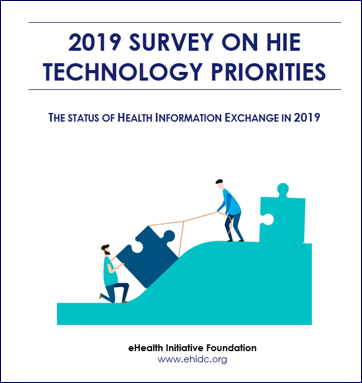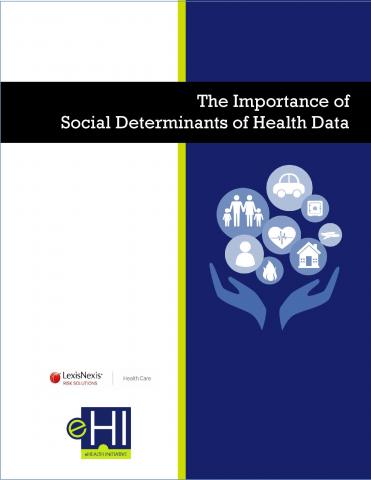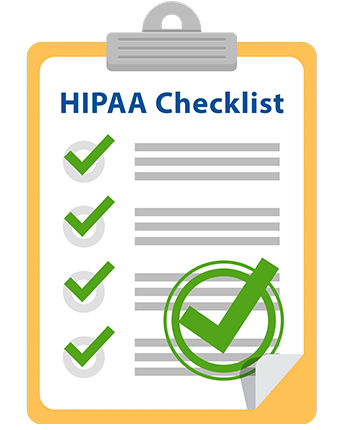Securing Connected Medical Devices
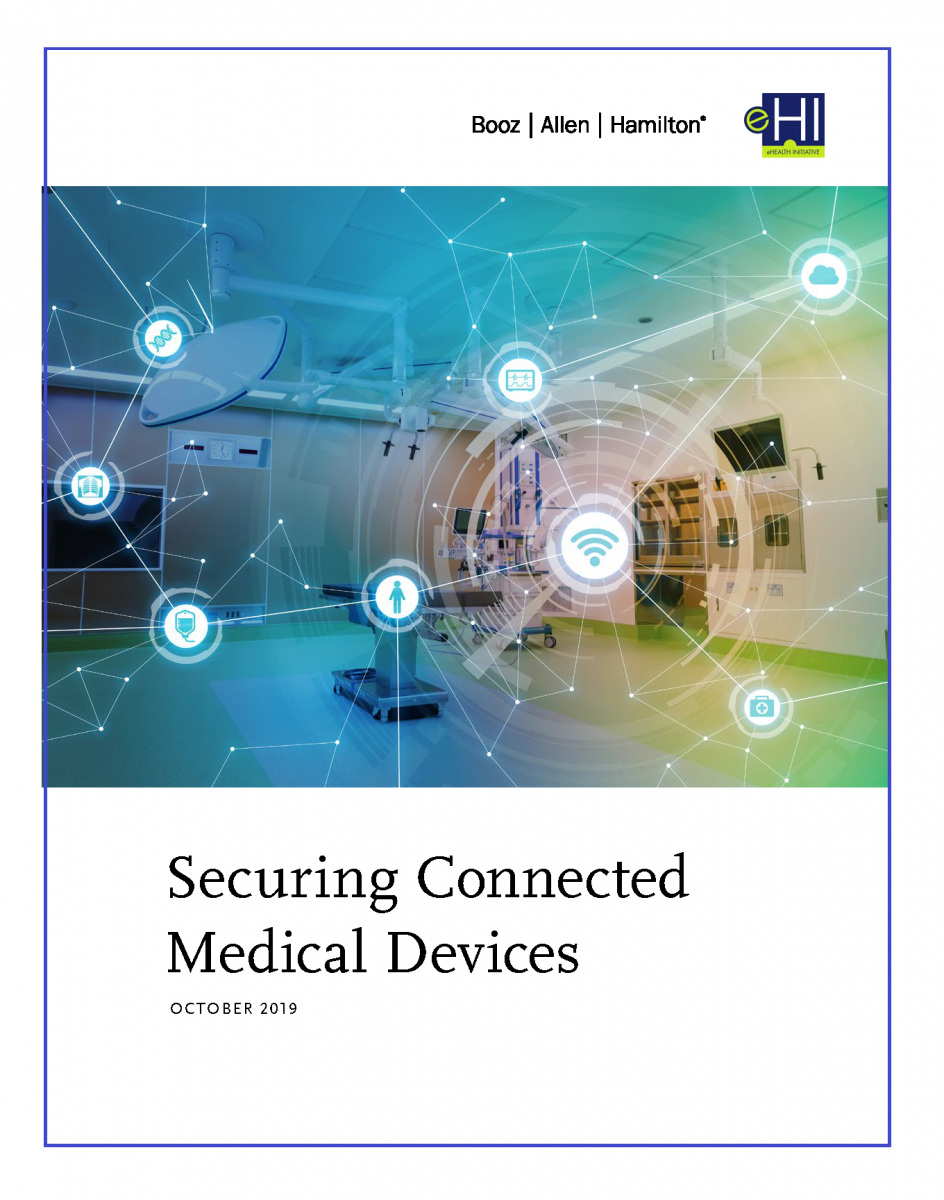 eHealth Initiative & Foundation (eHI) and Booz Allen Hamilton, released a joint report, Securing Connected Medical Devices, to help industry stakeholders address the challenges associated with the cyber security of connected medical devices. The rise of connected medical devices – which are devices that connect or integrate with other systems (e.g., other devices, tools, networks, services) – represent significant innovations in patient care. These innovations face new and diverse threats not previously in existence. As soon as a medical device is connected in some way – either wirelessly or wired, using a persistent connection or one that is transient, either one-directional or bi-directional – the medical device becomes much easier to disrupt, and the potential disruption much more severe. The medical device ecosystem is at a critical moment where strong leadership across industry, government, and the public is needed to prepare for a secure connected future.
eHealth Initiative & Foundation (eHI) and Booz Allen Hamilton, released a joint report, Securing Connected Medical Devices, to help industry stakeholders address the challenges associated with the cyber security of connected medical devices. The rise of connected medical devices – which are devices that connect or integrate with other systems (e.g., other devices, tools, networks, services) – represent significant innovations in patient care. These innovations face new and diverse threats not previously in existence. As soon as a medical device is connected in some way – either wirelessly or wired, using a persistent connection or one that is transient, either one-directional or bi-directional – the medical device becomes much easier to disrupt, and the potential disruption much more severe. The medical device ecosystem is at a critical moment where strong leadership across industry, government, and the public is needed to prepare for a secure connected future.
eHI Explains ICD-10-CM Coding for Social Determinants of Health

Download this information as 2-page document at the bottom of your screen.
- What is an ICD-10-CM code?
International Classification of Diseases, Tenth Revision, Clinical Modification coding, known as ICD-10-CM coding, is a system used by clinicians to classify and record all diagnoses and symptoms for care within the United States. Codes are based on the International Classification of Diseases, which is published by the World Health Organization (WHO), using unique alphanumeric codes to identify known diseases and other health problems. ICD-10-CM codes provide a level of detail that is necessary for storing and retrieving diagnostic information, compiling national mortality and morbidity statistics, and processing health insurance claims. - What is an ICD-10-CM Z code for Social Determinants of Health (SDOH)?
ICD-10-CM codes include a category called Z codes, which are used to describe experiences, circumstances, or problems that affect patient health, but are not considered a specific disease or injury. Z codes identify patients facing socioeconomic and psychosocial circumstances that may influence their health status and contact with health services. Currently, codes included in categories Z55-Z65 document patients’ SDOH in a standardized manner. - How does standardizing the capture of SDOH data codes benefit population health?
Traditionally, data recorded during a patient visit directly relates to a patient’s health but does not incorporate outside factors that can impact well-being. SDOH data captures information at a level traditional health data sources cannot, and ICD-10-CM Z codes can record this information, giving deeper insights into factors impacting health, such as employment, food insecurity, and housing. Standardizing SDOH would assist in identifying, documenting, and tracking additional markers of health, beyond the physical, and would permit clinicians, hospitals, and health plans to share the information through medical records and insurance claims data. - Are there guidelines for using ICD-10-CM codes for SDOH?
ICD-10-CM diagnosis codes have been adopted under the Health Insurance Portability and Accountability Act (HIPAA) for all healthcare settings. Guidelines for Z codes are included in the Centers for Medicare & Medicaid Services (CMS) ICD-10-CM Official Guidelines for Coding and Reporting for FY 2020. https://www.cdc.gov/nchs/data/icd/10cmguidelines-FY2020_final.pdf - Why should providers, non-physician healthcare providers, and coders use ICD-10-CM Z codes for SDOH?
Utilizing Z codes for SDOH enables hospitals and health systems to better track patient needs and identify solutions to improve the health of their communities. The extraction of SDOH data from the Electronic Health Record (EHR) for clinical, operational, and research purposes can facilitate tracking, identification, and referrals to social and governmental services. Rather than a new system or new tool to capture SDOH, leveraging existing ICD-10-CM codes offers an opportunity to expand on the existing system. This practical application brings SDOH into a clinician’s workflow and becomes a part of the patient’s electronic medical record and claims history. - What are the limitations of ICD-10-CM Z codes for SDOH?
Currently, Z codes for SDOH capture some, but not all, domains of SDOH. Stakeholder groups have requested that the ICD-10 Coordination and Maintenance Committee expand the codes to represent more granular information that would inform more precise, effective, and efficient social interventions, such as “barrier situations” which prevent consumers from obtaining medications and routine and preventive care. Although coding for SDOH is not mandated, when there is documentation of SDOH in the patient’s notes, it is still possible to use Z codes in the same manner that medical coding is done. Coding professionals may not know to scan for SDOH or may be hesitant to use the codes. Additionally, if a code has not been developed for a specific SDOH issue, the issue will not be coded and will not be included in the patient’s overall plan of care, nor as part of the claim submission process, unless it is recorded as narrative text. - Are coding professionals allowed to use non-physician documentation to support ICD-10-CM coding for societal and environmental conditions?
Yes, coding professionals at hospitals and health systems can report these codes based on documentation by all clinicians involved in the care of patients, such as case managers, discharge planners, social workers and nurses. In early 2018, the American Hospital Association’s (AHA) Coding Clinic published guidance that allows the reporting of SDOH ICD-10 codes based on non-physician documentation. The ICD-10-CM Cooperating Parties approved the advice, with the change effective February 2018. - Where can I find more resources and initiatives around SDOH data and ICD-10-CM Coding?
- American Hospital Association (AHA) Information sheet on ICD-10 Coding for Social Determinants of Health
- "Health Disparities: Social Determinants of Health)” (Free online education module by the American Medical Association (AMA)
- AMA’s Integrated Health Model Initiative (IHMI), Resource Link & Link 2
- AMA and UnitedHealthcare’s collaboration to support the creation of new ICD-10 codes related to SDOH
- Centers for Disease Control (CDC) Social Determinants of Health Webpage
- CMS 2020 ICD-10-CM Files
- CMS ICD-10-CM Official Guidelines for Coding and Reporting for FY 2020
- CMS’ Accountable Health Communities Health-Related Social Needs Screening Tool & FAQ
- Healthy People 2020’s Social Determinants of Health Webpage
- Humana Food Insecurity and Loneliness Toolkits
- The National Association of Community Health Centers (NACHC) Protocol for Responding to and Assessing Patients’ Assets, Risks, and Experiences (PRAPARE)
- American Academy of Family Physicians (AAFP)’s EveryONE Project Toolkit
- SIREN’s (Social Interventions Research and Evaluation Network) Gravity Project Resource Link & Link 2
- NCQA Population Health Management Resource Guide
2019 Survey on HIE Technology Priorities
Based on results from eHI’s 2019 Survey on HIE Technology Priorities, this report examines HIE perspectives on:
- Adoption of new technology
- Integrating clinical and claims data
- Types of data being exchanged
- Business drivers and priorities
- Challenges associated with the aforementioned
For almost two decades, eHealth Initiative and Foundation (eHI) has monitored the state of health information exchanges. Healthcare is experiencing rapid evolution with the emergence of new technologies and payment models. In response, both the public and private sectors are seeking ways to improve the quality and safety of care, resulting in a growing momentum to improve interoperability. Organizations like health information exchanges (HIEs) and health information networks (HINs) act as a source of valuable information and services, making the continued evaluation of their challenges, opportunities, and priorities important.
Background on Health Information Exchanges
As the name implies, HIEs provide technology and services to help their stakeholders exchange electronic health information. HIEs do not provide healthcare services. Instead, they impact the quality and cost of care, and ultimately outcomes, by sharing patient health data across organizations within a region, community, or hospital system.
Numerous trends that will drive the adoption of new technologies, the ability to exchange various data types, and the direction of HIE priorities are already evident in 2019. The healthcare industry is in the process of adopting performance-based funding models in place of more traditional reimbursement-based models. Industry is also facing an influx of value-based care initiatives; growing support for application programming interface (API) based interoperability standards, such as HL7®’s Fast Healthcare Interoperability Resources (FHIR®); complex laws for sharing non-traditional types of data; and the push for nationwide exchange of electronic health information across disparate HINs. As new payment models emerge, healthcare stakeholders are increasingly seeking out new types of data that will give a wider perspective of a patient’s health and social experiences.
An HIE’s ability to integrate data enables and supports value-based care. Stakeholders can monitor their quality and cost of care, leading to improvements in care quality and care coordination, and eventually, cost savings. However, not all HIEs have the ability to integrate the many types of data necessary to enable and support value-based care and cost-lowering activities. HIE capabilities may be limited for a variety of reasons, including technical functions, costs, competing priorities, and issues around ownership and control of the data by stakeholder organizations participating in the HIE.
EMMA’S CLIFF NOTES ON TUESDAY’S HELP HEARING – MARCH 26, 2019
IMPLEMENTING THE 21ST CENTURY CURES ACT: MAKING ELECTRONIC HEALTH INFORMATION AVAILABLE TO PATIENTS AND PROVIDERS, MARCH 26, 2019, SENATE HELP COMMITTEE, 10:00 AM EST
EMMA’s CLIFF NOTES ON TUESDAY’s HELP HEARING – MARCH 26, 2019
The Importance of Social Determinants of Health Data
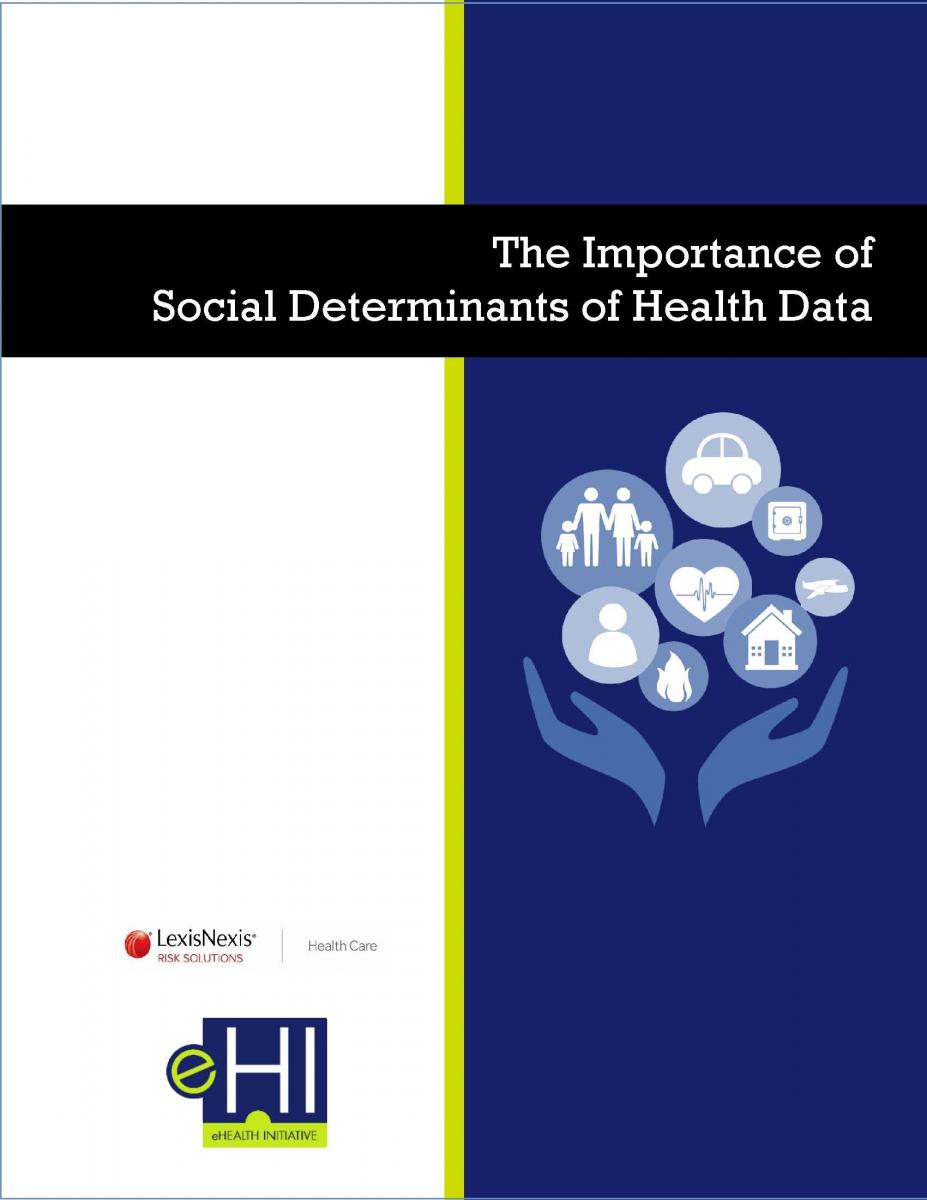 The Importance of Social Determinants of Health Data (SDOH) paper examines different industry approaches to addressing SDOH. The report demonstrates how SDOH data is critical to reducing cost and improving the quality of care provided by today’s healthcare system. In Winter 2018, eHealth Initiative Foundation and the LexisNexis® Risk Solutions healthcare business hosted the second in a series of roundtable meetings on data governance in healthcare. The roundtable focused on data governance from the perspective of Social Determinants of Health (SDOH), convening senior executives from across the healthcare spectrum. The goal of the meeting was to gather expert opinions on the use of SDOH data to benefit patients and providers. Medical care alone has a very limited effect on overall population health and could be significantly enhanced by pairing with approaches that address SDOH.[i] SDOH data is critical to reducing cost and improving the quality of care provided by hospitals and health systems.
The Importance of Social Determinants of Health Data (SDOH) paper examines different industry approaches to addressing SDOH. The report demonstrates how SDOH data is critical to reducing cost and improving the quality of care provided by today’s healthcare system. In Winter 2018, eHealth Initiative Foundation and the LexisNexis® Risk Solutions healthcare business hosted the second in a series of roundtable meetings on data governance in healthcare. The roundtable focused on data governance from the perspective of Social Determinants of Health (SDOH), convening senior executives from across the healthcare spectrum. The goal of the meeting was to gather expert opinions on the use of SDOH data to benefit patients and providers. Medical care alone has a very limited effect on overall population health and could be significantly enhanced by pairing with approaches that address SDOH.[i] SDOH data is critical to reducing cost and improving the quality of care provided by hospitals and health systems.
According to Healthy People, a U.S. Department of Health and Human Services (HHS) initiative providing science-based, 10-year national objectives for improving the health of all Americans, SDOH are conditions in the environments in which people are born, live, learn, work, play, worship, and age that affect a wide range of health, functioning, and quality-of-life outcomes and risks. Examples of social determinants include availability of resources to meet daily needs, such as safe housing and local food markets; access to educational, economic, and job opportunities; access to health care services; quality of education and job training; availability of community-based resources in support of community living; opportunities for recreational and leisure-time activities; transportation options; public safety; social support; social norms and attitudes, such as discrimination and racism; exposure to crime, violence, and social disorder; socioeconomic conditions, including concentrated poverty and the stressful conditions that accompany it; residential segregation; language and literacy; access to mass media and emerging technologies (e.g., cell phones, the Internet, and social media); and culture.[ii]
Risky Business? Sharing Data with Entities Not Covered by HIPAA
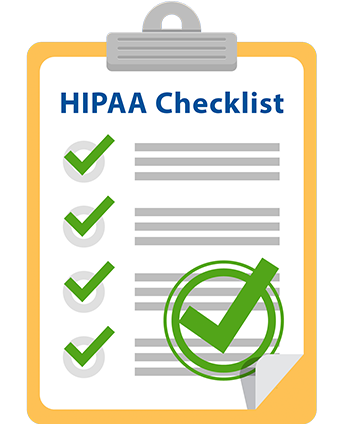
In 2018, eHealth Initiative Foundation (eHI) and Manatt, Phelps & Phillips hosted two executive advisory board meetings on privacy and security in the age of wearable technologies. The risky business of sharing data In and Outside of the healthcare system is becoming more complicated, especially as consumer use of health applications and the desire to share health data increases exponentially. The roundtables convened experts in healthcare privacy and security, explored data sharing within and between organizations (including the relationships healthcare providers have with business associates and application (app) developers), and tackled data sharing implications for the bio-economy and the state, federal, and international policies and rules that aim to guide organizations through the murky terrain. The brief examines the significant amount of health data being generated from apps and consumer devices that are ungoverned by HIPAA and aims to clear up some of the confusion, offering tangible examples of what constitutes a covered and non-covered HIPAA entity, how to determine business associates in relation to HIPAA, provides an examination of federal guidance and regulations for covered entities and app developers, and discusses the nuances of the California Consumer Privacy Act (CCPA) and the General Data Protection Regulation (GDPR).
Prior Authorization: Current State, Challenges, and Potential Solutions
 The prior authorization (PA) process is entrenched in today’s healthcare system. Prior authorization is a decision by a payer that a healthcare service, treatment plan, prescription drug, or durable medical equipment is medically necessary and is included in a member’s coverage. Although PA is meant to ensure appropriate, cost-effective healthcare, it often creates barriers and administrative burdens for providers, payers, and patients. In a world where rovers roam capably on Mars, PA is still a broken process. Fixing PA will alleviate stress for patients and providers and reduce costs for healthcare as a whole.
The prior authorization (PA) process is entrenched in today’s healthcare system. Prior authorization is a decision by a payer that a healthcare service, treatment plan, prescription drug, or durable medical equipment is medically necessary and is included in a member’s coverage. Although PA is meant to ensure appropriate, cost-effective healthcare, it often creates barriers and administrative burdens for providers, payers, and patients. In a world where rovers roam capably on Mars, PA is still a broken process. Fixing PA will alleviate stress for patients and providers and reduce costs for healthcare as a whole.
In Fall 2018, eHealth Initiative (eHI) and Virence Health (now a part of athenahealth) embarked on a project to find practical solutions for fixing PA. eHI began the endeavor by gathering feedback from high-level executives during structured interviews, specifically:
- Provider perspectives on PA and appropriate use criteria in the workflow
- Organizational approaches to implementing PA
- Strategic organizational goals around PA
- Barriers limiting the automation and implementation of PA
- Actions that policymakers, payers, and patients could take to improve PA
These interviews set the groundwork for two roundtable discussions that convened multiple stakeholders throughout healthcare. Stakeholders were well versed in the subject of PA, representing the issue from various perspectives with hundreds of years of collective experience in the health IT sector. As a component in eHI’s Prior Authorization Initiative, this brief discusses the current state of PA, and offers examples of initiatives, from the field, that are working to address PA. Download the full report below.
Whitepaper: Using Actionable Insights Management to Improve Collaboration and Outcomes in Healthcare
October 2018 whitepaper from Sonora Quest Laboratories and Commonwealth Primary Care ACO.
ACO success requires current and relevant data access. Data in healthcare is often siloed, challenging to aggregate, and difficult to act on. In order to be effective in this new healthcare landscape, Sonora Quest Laboratories (SQL) and Commonwealth Primary Care ACO (Commonwealth) worked together to analyze information from their respective patient databases in order to assist Commonwealth in serving their patients.
This paper demonstrates how the strategic partnership between Commonwealth and SQL resulted in actionable patient data, improved communications with providers, and also led to the development of data-focused care models utilizing SQL’s Actionable Insights Management™ (AIM™) analytics platform.
All Together Now: Applying the Lessons of Fee-for-Service to Streamline Adoption of Value-Based Payments
Value-based payment models are transforming a sizable portion of the U.S. healthcare economy by aligning provider compensation with improvements in care and cost controls. However, this shift in the way care is measured, billed and paid is far from complete or certain. Innovation and experimentation are ongoing, and a range of issues could slow or add costs to progress.
You can enjoy total interoperability today!
There's no need to wait years to achieve partial interoperability.
TOTAL interoperability is available today with our groundbreaking MedKaz® patient-focused personal health record. It is the only system that assembles a patient's COMPLETE record from ALL his or her providers in one place and is instantly available at the point of care whether at home or away. If you can log on to a computer, perform a search and read a document in a browser you can use MedKaz! It is updated for your following each encounter you have with a care provider.
For example, I have ALL of my records from ALL of my providers for the past 35 years on my MedKaz which I carry on my keychain. My providers were located in six cities and three state, and include every charting system you can think of— from paper charts to virtually every EMR system.
To learn more about MedKaz and how it benefits everyone in the healthcare equation, including the patient, his or her providers, employer, and insurer, visit our website: medkaz.com.
We'll be happy to discuss it with you and even demo it for you at your convenience.

